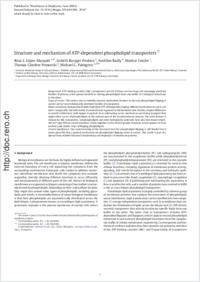Structure and mechanism of ATP-dependent phospholipid transporters
- López-Marqués, Rosa L. Centre for Membrane Pumps in Cells and Disease – PUMPkin, Department of Plant and Environmental Sciences, University of Copenhagen, Denmark
- Poulsen, Lisbeth Rosager Centre for Membrane Pumps in Cells and Disease – PUMPkin, Department of Plant and Environmental Sciences, University of Copenhagen, Denmark
- Bailly, Aurélien Institute of Plant Biology, University of Zürich, Switzerland
- Geisler, Markus Department of Biology, Plant Biology, University of Fribourg, Switzerland
- Pomorski, Thomas Günther Centre for Membrane Pumps in Cells and Disease – PUMPkin, Department of Plant and Environmental Sciences, University of Copenhagen, Denmark
- Palmgren, Michael G. Centre for Membrane Pumps in Cells and Disease – PUMPkin, Department of Plant and Environmental Sciences, University of Copenhagen, Denmark
-
16.04.2014
Published in:
- Biochimica et Biophysica Acta (BBA) - General Subjects. - 2015, vol. 1850, no. 3, p. 461-475
English
Background: ATP-binding cassette (ABC) transporters and P4-ATPases are two large and seemingly unrelated families of primary active pumps involved in moving phospholipids from one leaflet of a biological membrane to the other.Scope of review: This review aims to identify common mechanistic features in the way phospholipid flipping is carried out by two evolutionarily unrelated families of transporters.Major conclusions: Both protein families hydrolyze ATP, although they employ different mechanisms to use it, and have a comparable size with twelve transmembrane segments in the functional unit. Further, despite differences in overall architecture, both appear to operate by an alternating access mechanism and during transport they might allow access of phospholipids to the internal part of the transmembrane domain. The latter feature is obvious for ABC transporters, but phospholipids and other hydrophobic molecules have also been found embedded in P-type ATPase crystal structures. Taken together, in two diverse groups of pumps, nature appears to have evolved quite similar ways of flipping phospholipids.General significance: Our understanding of the structural basis for phospholipid flipping is still limited but it seems plausible that a general mechanism for phospholipid flipping exists in nature. This article is part of a Special Issue entitled Structural biochemistry and biophysics of membrane proteins.
- Faculty
- Faculté des sciences et de médecine
- Department
- Département de Biologie
- Language
-
- English
- Classification
- Biological sciences
- License
- License undefined
- Identifiers
-
- RERO DOC 210214
- DOI 10.1016/j.bbagen.2014.04.008
- Persistent URL
- https://folia.unifr.ch/unifr/documents/303822
Statistics
Document views: 98
File downloads:
- gei_sma.pdf: 356
